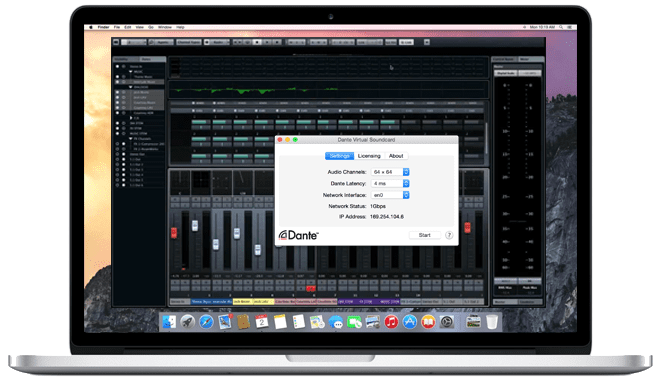

- #Dante virtual soundcard review software#
- #Dante virtual soundcard review Pc#
- #Dante virtual soundcard review professional#
- #Dante virtual soundcard review series#
- #Dante virtual soundcard review download#
I don't see this protocol as a simple plug-and-play for a consumer application except for point to pont (or you have network engineering expertise) in which case an USB will do just as well without the transceiver complexity. Then there is the issue of variable latency in a shared IP network unless the network is purpose-built with QoS guarantees for latency. PTP is just for clock synchronization as far as I understand it. However, if it is on a shared IP network, then I am not sure how the network latency is automatically figured out. If there is a peer-peer direct connection between them then that is the latency for transmission. The sender could decide to send packets at a slower speed than that. This is hardwired into the transceiver (which knows what latency happens inside its processing) and is the same on any network (topology). So that is the minimum latency requirement as far as that transceiver is concerned. If a transceiver at the other end cannot process packets faster than every X ms (including buffering), there is no reason to send packets faster than that. May be I misunderstood but last time I looked at Dante specs, the latency "handshake" was designed to manage transceiver processing latency (not network latency).
#Dante virtual soundcard review series#
With modern gigabit switches, you could probably stack 10+ switches in series and still not cause them to fail the 1ms handshake. Given that the DAC/ADC also have some inherent latency, I'm guessing you'd get somewhere around 3ms from analog input to output.
#Dante virtual soundcard review professional#
"Guaranteed latency" is one of the selling points of Dante for big professional workflows. Most higher end Dante products can handshake at 500μs or even 250μs, using standard gigabit switches. They do this by testing the line with PTP first to establish clock, so in this case the remaining 600μs would be buffer. The units can be configured to handshake at 1ms, 2ms, or 5ms. These models have 10/100 ethernet ports, meaning through a single switch there's probably about 400μs between them. Dante stuff works by "handshaking" at a set latency every time. The primary purpose of these is to integrate with other Dante products, but you can configure them to send directly to each other. are welcome.Ĭlick to expand.Forgive me for replying to so many posts on here hah. You have the data to decide otherwise.Īs always, questions, comments, recommendations, etc. Overall, I like to recommend the Dante AVIO modules but based on pure performance, I can't. In a pro, sound enforcement situation, the robustness should make them a good fit as long as you realize the performance degradation over just running an analog connection to a good ADC. You will only make things worse, not better. Don't even think about using them on your JBL SDP-55 processor hoping to get better performance than internal DACs. We are short of that so I am disappointed in that regard. Still, I like to see at least clean, 16 bit performance out of them. In understand these are entry level modules from Dante.
#Dante virtual soundcard review software#
The software can be a bit difficult to use but once you figure it out, you can get things done. I really like the plug-and-play aspects of these modules for streaming audio over ethernet. So you can only lower the performance, not better it than what I have shown.

Per above introduction, I configured the output module for 44.1 and ran our dashboard: You have to reconfigure the module to play other sample rates which are supported up to 96 kHz. You set the sample rate and that is the only rate that the module works at. Note that there is no dynamic sample rate switching. The ADC/DAC modules are not perfect so let's measure them independently and then together. And of course with no digital loss in the interconnect.
#Dante virtual soundcard review Pc#
Alternatively the modules can be configured to talk to each other without a PC in the middle allow you to extend balanced audio over Ethernet to wherever that interface goes. They also have a neat Dante Virtual Soundcard which creates either an ASIO or WDM interface (in Windows) to treat the modules as if they are hardwired to your computer.
#Dante virtual soundcard review download#
There is software you need to download to configure them (Dante Controller). The owner sent me an HP PoE switch which I used for testing. Power is provided over Ethernet (PoE) so there are no adapters or dongles to worry about.


 0 kommentar(er)
0 kommentar(er)
